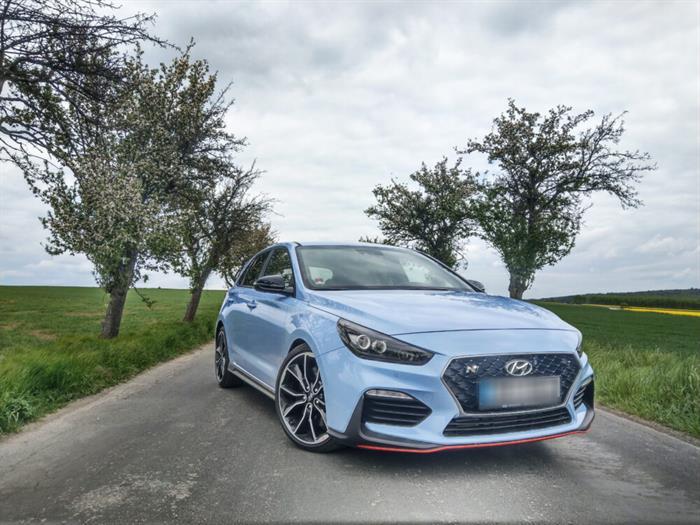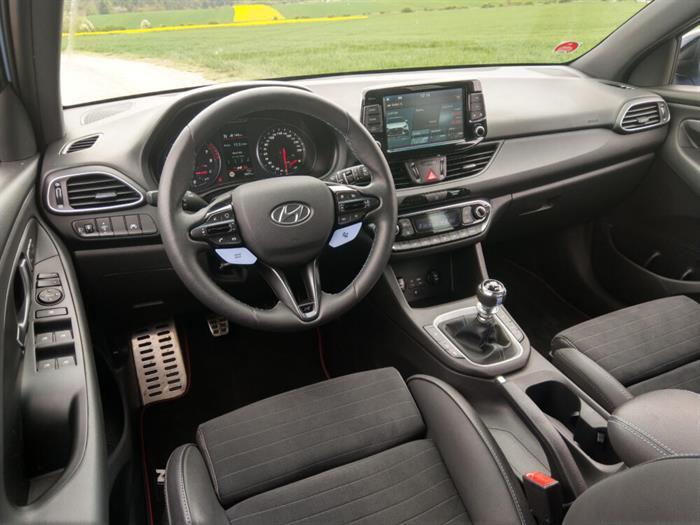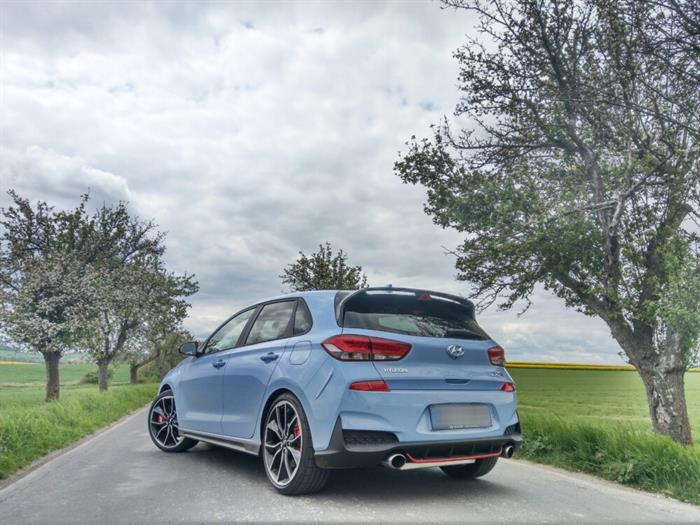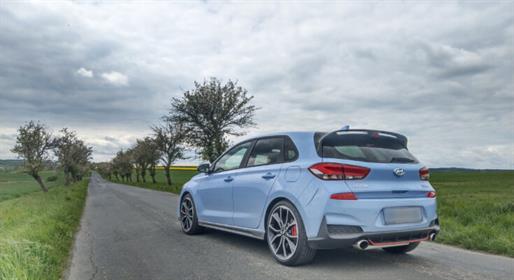Also this year, two i30 N Performance specification cars anchored in the Hyundai press fleet. These were both body variants, hatchback and fastback. And since we last tested the fastback version, this time it was the turn of the "short" version.
The Hyundai i30 N Performance is a sharp hothatch that I always look forward to testing. You simply know what to expect. A car that very easily changes its characteristics from a quite calm companion for everyday driving to a beast that has a huge draw, burns automatic intermediate gases and very willingly shoots into the exhaust.

Exterior
The tested "enko" had the typical color specification for it, i.e. the elegant Performance Blue color, in which it looks simply great.
As part of the front part, we have a more prominent front bumper with large intake holes, or a differently shaped front mask. The side profile will offer very decent 19" inch discs, which are shod in low tires with dimensions of 235 / 35. Through the giant and decently segmented discs, the red painted brakes equipped with the "N" logo peek out.
Choosing a body design (hatchback x fastback) is definitely not easy. Boot size aside, each one offers a very distinctive approach when dealing with the rear. The hatchback comes with a distinctive roof lollipop with an integrated brake light, while the fastback comes with an elegant tear-off edge and a central fog light, which is located in the lower part of the rear bumper.
I personally don't have a favorite, I like both. The fastback underlines the sporty character of the car, the hatchback, on the other hand, is an inconspicuous "family" car, which can then greatly overwhelm the other competitors.

Interior
I have always been satisfied with the interior of the i30, due to its logical layout and good interior ergonomics. Its weak points include a certain obsolescence, mainly in the handling of the individual infotainment displays and in the instrument cluster. This deficiency will certainly be solved with the arrival of the new, modernized i30.
The interior of the "sharp" N Performance version differs from the regular i30 in several details. The first is the excellent seats with pronounced lateral guidance, which are of course electrically adjustable and heated. There is also a multi-functional steering wheel with a really massive ring, which, in addition to the standard controls for the cruise control, telephone, audio system and on-board computer, also has a pair of special buttons for selecting driving modes.
The shift lever is also excellent, it has a round sports head and a very mechanical operation. The instrument panel is quite classic, it has a pair of analog tachometer and speedometer indicators. Between them is the on-board computer display. Enko, however, is an original pair of indicators, the first, following the engine temperature, shows you how far it is appropriate to rev the vehicle, and the second, which shows you when it is appropriate to shift to a higher gear.
The rear seats offer plenty of space, thanks to the classic hatchback body also in the overhead space. The luggage compartment itself is easily accessible, and in the tested version its loading area is slightly limited by a steel reinforcement.

Motorization and its driving performance
The I30 N Performance is still a very "moody" car in terms of driving behavior : – ) The difference in its behavior depending on the selected driving mode is really wide. Enko still has the classic ECO, NORMAL and SPORT modes, which you select with the left button on the multifunction steering wheel. Where there is a left button, there should usually be a right button, and it is the same with Enko. The right button then activates the sharp "N" mode and the fully adjustable "CUSTOM" mode. The listed driving modes then have an overlap mainly in engine response, differential operation, exhaust volume, shock absorber settings, power steering settings, electronic stability control settings, etc.
After starting the car, the NORMAL mode is always activated, in which the car presents itself as a "family" hatchback with a stiffer chassis and steering. I personally did not use this mode in practice. The next mode is ECO, which I used quite a lot on longer journeys on the highway, when you have a comfortable highway speed set on the cruise control and you enjoy quite calm driving. Enko will repay you in this situation with a very respectable consumption of around 8.5 liters per 100 km. The Sport mode is already quite different, the settings of everything except the ESC will change. The response to the gas pedal accelerates, the chassis and power steering stiffen, the differential's grip increases, and the sides of the response from the exhaust also change, which then becomes significantly more "eloquent".
The real hell begins when you activate the "N" mode, which will intensify everything even more. The chassis itself is much stiffer and the engine revs even more willingly. An interesting feature is the Rev-Matching function, which adequately equalizes the engine speed when downshifting – this is a significantly faster reaction than with classic intermediate gases. The "N" mode is more of a circuit mode, the chassis is really very hard and almost unusable in, for example, urban surfaces.
A gift from heaven is the CUSTOM mode, in which you can personalize all parameters of the car settings. The ideal combination for me was to set the steering and chassis to NORMAL and everything else to SPORT +. The Enko is pleasantly explosive and powerful with a nice booster effect and a chassis hardness that doesn't try to grind away all your tooth enamel.
As for the consumption, I have already described the idle mode, in the sharp mode the consumption will shoot well above ten liters, proportional to your "pulling" on the gas. So on average, count on a consumption of around 12 liters per 100 km.
The Enko stands out for its high body stiffness, the tested Performance variant also has the previously mentioned spacer between the shock absorbers in the luggage compartment, which further increases its stiffness. The front axle is then equipped with a self-lock, so both wheels engage at the same time and you will simply enjoy exiting corners. The car is also equipped with a great six-speed manual with short and mechanically precise shifting paths. The steering must also be praised, for its clear response from the wheels, its characteristics then of course change with the selected driving mode.
Since last year, the enko has been equipped with a particulate filter, which unfortunately reduced the exhaust system by a few decibels. Even so, the sound of this car is famous, the way it "grunts" when you lightly tease it with the gas, or how it shoots under full throttle, these are addictive things that are really hard to describe.
The interplay of this engine, transmission, differential, chassis and steering makes the "enka" a real driver's car to get used to. The car certainly doesn't give you anything for free, but driving it is authentic and simply great.

In conclusion
The "Enko" version of the Hyundai i30 still offers a very interesting and favorable price policy. Looking at the current price list, I find that you can get the basic i30 N as part of the promotional price for 699,990 CZK including VAT. The basic I 30 N then has a turbocharged two-liter engine with an output of 184 kW (250 hp).
The N Performance version, which passed our editorial test, and which, in addition to the classic "enko", offers nineteen-inch wheels, a two-liter engine with an output of 202 kW (275 hp), an electronically controlled differential, reinforcement of the luggage compartment, larger brake discs and a variable valve of the exhaust system, so, paradoxically, you will still be purchasing only CZK 40,000 more expensive, i.e. for the amount of CZK 739,990 including VAT.
For comparison, the basic "fastback" Enko starts at 719,990 CZK including VAT, while the Fastback N Performance starts at 759,990 CZK including VAT.
Even in 2020, the Hyundai i30N is a car you can't help but fall in love with. What I still appreciate about it is its driving variety, it can be very aggressive, fast and fun, on the other hand, thanks to the great variety of its driving modes, supple and everyday usable.
Source: Author's text
Image source: Author's own photos



























